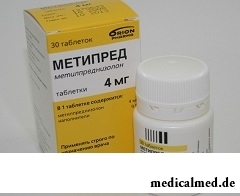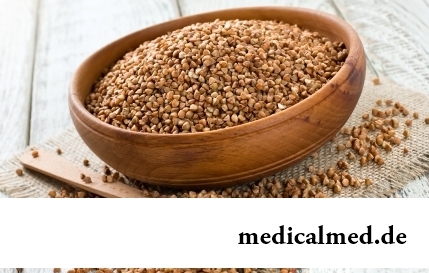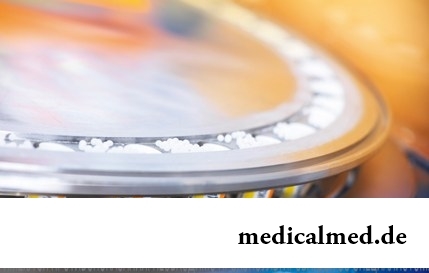





Methypredum
Application instruction:
 Methypredum – the drug having an antiinflammatory and immunodepressive effect.
Methypredum – the drug having an antiinflammatory and immunodepressive effect.
Form of release and structure
Methypredum is issued in two dosage forms:
- Tablets: from white till almost white color, flat, round, with slanted edge and dividing cross risky on one of the parties; tablets on 16 mg – on the party with risky the ORN 346 code is put (on 30, 100 pieces in bottles or containers, on 1 bottle or a container in a cardboard pack);
- Lyophilisate for preparation of solution for intravenous and intramuscular administration: the white or slightly yellowish hydroscopic lyophilized powder; the enclosed solvent – colourless transparent liquid (on 250 mg in bottles, on 1 bottle in a cardboard pack; in a set – solvent (water for injections) in ampoules on 4 ml).
Is a part of 1 tablet:
- Active ingredient: Methylprednisolonum – 4 or 16 mg;
- Auxiliary components: corn starch, monohydrate of lactose, magnesium stearate, talc, gelatin, the water purified.
With lyophilisate is a part of 1 bottle:
- Active ingredient: Methylprednisolonum – 250 mg (in the form of sodium succinate);
- Auxiliary component: sodium hydroxide.
Indications to use
Tablets:
- Inflammatory diseases of joints (acute and chronic): Bekhterev's disease, juvenile arthritis, a bursitis, arthritis (psoriasis, gouty), an osteoarthritis (including posttraumatic), a humeroscapular periarthritis, polyarthritis (including senile), nonspecific tendosinovit, a synovitis and an epicondylitis, Steel's syndrome at adults;
- System diseases of connecting fabric: scleroderma, system lupus erythematosus, dermatomyositis, nodular periarteritis, pseudorheumatism;
- Rheumatic carditis, acute rheumatism, hysterical chorea;
- Asthmatic status, bronchial asthma;
- Skin diseases: a pemphigus, eczema, psoriasis, atopic dermatitis, exfoliative dermatitis, violent herpetiform dermatitis, contact dermatitis (with a big area of defeat), seborrheal dermatitis, a toxidermia, a Lyell's disease and Stephens-Johnson;
- Allergic diseases (chronic and acute), including allergic reactions to some foodstuff and medicines, a serum disease, a small tortoiseshell, allergic rhinitis, a medicinal dieback, Quincke's edema, pollinosis;
- Wet brain (including connected with carrying out surgical intervention or radiation therapy, an injury of the head or arisen against the background of brain tumors) after preliminary injection introduction of GKS (including Methypredum in the form of solution for in/in and introductions in oil);
- Diseases of eyes of allergic and inflammatory character: allergic forms of conjunctivitis, sympathetic ophthalmia, optic neuritis, heavy slow back and front uveites;
- Adrenal insufficiency (primary or secondary), including states after removal of adrenal glands;
- Nephrotic syndrome;
- Inborn adrenal struma;
- The diseases of kidneys having autoimmune genesis including an acute glomerulonephritis;
- Subacute thyroiditis;
- Diseases of system of a hemopoiesis and blood: miyelo-and lymphoid leukoses, an agranulocytosis, a Werlhof's disease, a panmyelopathia, secondary thrombocytopenia at adults, autoimmune hemolitic anemia, a lymphogranulomatosis, erythrocyte anemia (eritroblastopeniya), erythroidal (inborn) hypoplastic anemia;
- Pulmonary tuberculosis, tubercular meningitis, aspiration pneumonia (along with carrying out specific chemotherapy);
- Intersticial pulmonary diseases: pneumosclerosis, acute alveolitis, sarcoidosis of the II-III stage;
- Lung cancer (along with use of tsitostatik);
- Berylliosis, Leffler's syndrome (at inefficiency of other methods of treatment);
- Disease Krone, ulcer colitis, local enteritis;
- Multiple sclerosis;
- Hypoglycemic states;
- Hepatitis;
- Multiple myeloma;
- The hypercalcemia connected with oncological diseases, the vomiting and nausea connected with performing cytostatic therapy;
- Reactions of graft rejection at organ transplantation (as prophylactic).
Lyophilisate for preparation of injection solution:
The emergency treatment at the states demanding bystry increase in concentration of active ingredient in an organism.
- Depressed cases (toxic, traumatic, burn, operational, cardiogenic shock) in cases of inefficiency of plasma substituting and vasoconstrictive drugs and other symptomatic therapy;
- Hemotransfusionic shock, allergic reactions (in acute severe forms), anaphylactoid reactions, an acute anaphylaxis;
- Wet brain (including connected with carrying out surgical intervention, radiation therapy, an injury of the head or arisen against the background of a brain tumor);
- Hepatic coma, acute hepatitis;
- Bronchial asthma (in a severe form), the asthmatic status;
- Acute adrenal insufficiency;
- Pseudorheumatism, system lupus erythematosus;
- Thyrocardiac crisis;
- Poisoning with the cauterizing liquids (for reduction of the inflammatory phenomena and the prevention of cicatricial narrowings).
Contraindications
Hypersensitivity to components of Methypredum is the only contraindication for performing short therapy according to vital indications.
At children in a growth period drug needs to be used only under careful observation of the doctor and according to absolute indications.
It is necessary to appoint Methypredum with care in the presence of the following diseases and/or states:
- Digestive tract diseases: an esophagitis, a peptic ulcer of a stomach and duodenum, a round ulcer (acute or latent), gastritis, recently created intestines anastomosis, a diverticulitis, nonspecific ulcer colitis (in the presence of threat of development of perforation or abscessing);
- Diseases of endocrine system: diabetes mellitus, hypothyroidism, obesity (III-IV degree), thyrotoxicosis, disease of Itsenko-Kushinga;
- Infectious and parasitic diseases of the virus, bacterial or fungal nature (now or postponed in recent time, including contacts with patients): chicken pox, a herpes simplex, a viremichesky phase of the surrounding herpes, measles, an amebiasis, system mycosis, a strongyloidosis; latent and active tuberculosis (at serious infectious diseases use is admissible only against the background of specific treatment);
- Pre-and the postvaccinal period (in 2 months prior to and 14 days later after vaccination), lymphadenitis after BTsZh inoculation, immunodeficiency (including AIDS or HIV infection);
- Diseases of cardiovascular system, arterial hypertension, heavy chronic heart failure, lipidemia;
- Hypoalbuminemia and states contributing to its development;
- Nefrourolitiaz, heavy chronic liver and/or renal failure;
- System osteoporosis, acute psychosis, myasthenia гравис, poliomyelitis (except a form of bulbar encephalitis), glaucoma (open and closed-angle);
- Pregnancy.
At pregnancy (in particular in the I trimester) Methypredum can be applied only according to vital indications, during a lactation breastfeeding needs to be interrupted.
Route of administration and dosage
The dose of Methypredum and duration of therapy is established individually by the doctor on the basis of indications and weight of disease.
Tablets:
Methypredum is accepted inside, washing down with a small amount of liquid, it is more preferable – in time or right after food. The daily dose is accepted once; a double daily dose – every other day, considering a circadian rhythm of endogenous secretion of glucocorticosteroids between 6 and 8 o'clock in the morning (the high daily dose is divided into 2-4 receptions, at the same time the high dose is recommended to be accepted in the morning).
Depending on the nature of a disease the initial daily dose of drug can vary within 4-48 mg. At treatment of less serious illness it is usually enough to apply lower doses though also higher doses in certain cases can be required.
In high daily doses Methypredum is usually appointed at treatment of the following diseases:
- Organ transplantation: to 7 mg/kg;
- Wet brain: 200-1000 mg;
- Multiple sclerosis: 200 mg.
If the satisfactory clinical effect is not gained through a sufficient span, it is necessary to cancel Methypredum and to appoint other type of therapy.
The daily dose for children is calculated taking into account a body surface or weight (in 3 receptions):
- Adrenal insufficiency: 3,33 mg/m ² or 0,18 mg/kg;
- Other indications: 12,5-50 mg/m ² or 0,42-1,67 mg/kg.
After long therapy the daily dose needs to be reduced gradually (sharply it is impossible to stop treatment).
Lyophilisate for preparation of injection solution:
Methypredum is entered intramusculary or in the form of slow intravenous jet injections or intravenous infusions.
For preparation of solution just before use solvent is added to a bottle with lyophilisate. The prepared solution contains 62,5 mg/ml of Methylprednisolonum.
At life-threatening conditions of 30 mg/kg of Methypredum enter intravenously for not less than 30 minutes (as additional therapy). It is possible to repeat introduction of the same dose for 48 hours each 4-6 hours.
During pulse therapy at treatment of diseases at which glucocorticosteroids are effective exacerbations of diseases and/or inefficiencies of standard methods of treatment appoint Methypredum as follows (intravenously):
- Rheumatic diseases: 1-4 days on 1000 mg a day or 6 months on 1000 mg a month;
- Multiple sclerosis: 3 or 5 days on 1000 mg a day;
- System lupus erythematosus: 3 days on 1000 mg a day;
- Edematous states (for example, lupoid nephrite, glomerulonephritis): 4 days on 30 mg/kg every other day or 3, 5 or 7 days on 1000 mg a day.
The above-stated doses need to be entered for not less than 30 minutes. If in 7 days of performing therapy improvement was not reached or if it is demanded by a condition of the patient, introduction can be repeated.
At end-stages of oncological diseases for improvement of quality of life daily enter intravenously 125 mg a day for 2 months.
During the chemotherapy which is characterized by srednevyrazhenny or insignificant emetic action intravenously enter 250 mg of Methypredum for not less than 5 minutes. Drug is used in 1 hour prior to administration of chemotherapeutic drug, at the beginning of carrying out chemotherapy and after its termination. At the expressed emetic action accompanying chemotherapy intravenously enter 250 mg within not less than 5 minutes along with the corresponding doses of phenyl propyl ketone or Metoclopramidum in 1 hour prior to administration of chemotherapeutic drug, then on 250 mg at the beginning of chemotherapy and after its termination.
The initial dose at other indications depending on the nature of a disease makes 10-500 mg (intravenously). For short courses at acute serious conditions higher doses can be required. The initial dose to 250 mg needs to be entered for not less than 5 minutes, higher doses – not less than 30 minutes. The following doses can be entered intravenously or intramusculary, duration of intervals between introductions is defined by reaction of the patient to treatment and its clinical state.
To children appoint lower doses (but not less than 0,5 mg/kg a day), however first of all at the choice of a dose it is important to consider not the body weight and age of the patient, but weight of a state and reaction to therapy.
Side effects
Expressiveness and frequency of development of side effects are defined by the therapy duration, size of a dose and an opportunity to observe a circadian rhythm of use of Methypredum.
During treatment there can be following disturbances:
- Cardiovascular system: arrhythmias, bradycardia (up to a cardiac standstill); at predisposition – strengthening or development of expressiveness of heart failure characteristic of a change hypopotassemia on an ECG, hypercoagulation, increase in arterial pressure, fibrinferment; at a myocardial infarction (acute and subacute) – delay of formation of cicatricial fabrics, distribution of the centers of a necrosis (can cause a rupture of a cardiac muscle);
- Alimentary system: gastrointestinal bleedings, erosive esophagitis, nausea, pancreatitis, vomiting, steroid stomach ulcer and duodenum, appetite disturbance, perforation of walls of digestive tract, digestion disturbance, hiccups, meteorism; seldom – increase in activity of an alkaline phosphatase and hepatic transaminases;
- Central and peripheral nervous system: euphoria, maniac-depressive psychosis, delirium, disorientation, hallucinations, spasms, depression, paranoia, increase in intracranial pressure, concern, nervousness, dizziness, sleeplessness, cerebellum pseudoneoplasm, вертиго, headache;
- Musculoskeletal system: closing before the term of epiphyseal regions of growth (delay of processes of ossification and growth at children), a rupture of sinews of muscles, osteoporosis, a steroid myopathy, decrease in muscle bulk;
- Endocrine system: oppression of function of adrenal glands, a steroid diabetes mellitus, decrease in tolerance to glucose, manifestation of a latent diabetes mellitus, an Icenco-Cushing syndrome (in the form of a crescent-shaped face, increase in arterial pressure, obesity of pituitary type, a hirsutism, an amenorrhea, a dysmenorrhea, muscular weakness, striya); children have a delay of sexual development;
- Metabolism: a hypocalcemia, the increased calcium removal, increase in body weight, negative nitrogenous balance, the increased perspiration; because of mineralokortikoidny activity of drug – a hypernatremia, a delay of sodium and liquid, a gipokaliyemichesky syndrome (in the form of arrhythmia, a hypopotassemia, a mialgiya or a spasm of muscles, unusual fatigue and weakness);
- Sense bodys: tendency to development of consecutive fungal, bacterial or viral infections of eyes, a back subkapsulyarny cataract, increase in intraocular pressure, an exophthalmos, trophic changes of a cornea, sudden loss of sight (at administration of solution in a neck, the head, head skin, nasal sinks adjournment of crystals of Methypredum in eye vessels is possible);
- Allergic reactions: skin rash, acute anaphylaxis, itch, local allergic reactions;
- Dermatological reactions: thinning of skin, the slowed-down healing of wounds, ecchymomas, petechias, hypo - or a hyperpegmentation, striya, steroid eels, increase in risk of developing of candidiases and a pyoderma;
- Local reactions at intravenous or intramuscular administration: infection of an injection site, numbness, burning, a pricking, pain in an injection site; seldom – formation of hems in the place of an injection, a necrosis of surrounding fabrics, an atrophy of hypodermic cellulose and skin at intramuscular introduction (in particular it is dangerous to administer the drug in a deltoid muscle);
- Others: an aggravation or development of infections (emergence of this disturbance is promoted by vaccination and the immunodepressants applied jointly), "inflows" of blood to the head, a withdrawal, a leukocyturia.
Special instructions
During use of Methypredum (especially long) it is necessary to undergo observation at the oculist, to control the arterial pressure, a condition of water and electrolytic balance, and also a picture of peripheral blood and concentration of glucose in blood.
It is possible to apply antacids to reduction of side effects, and also to increase receipt in a potassium organism (observance of a diet, potassium administration of drugs). Food has to be vitamin-rich, proteins, with restriction of content of carbohydrates, fats and table salt.
Medicinal interaction
At simultaneous use of Methypredum with some drugs there can be following effects:
- Ethanol and non-steroidal anti-inflammatory drugs: strengthening of risk of emergence of erosive cankers in digestive tract and development of bleedings;
- Liver microsomal enzymes: decrease in concentration of Methypredum and increase in speed of metabolism;
- Anticoagulants and trombolitik: increase in risk of development of bleedings from ulcers in digestive tract;
- Cardiac glycosides: deterioration in their portability and increase in probability of development of ventricular premature ventricular contraction;
- Insulin and peroral hypoglycemic drugs, antihypertensives: reduction of their efficiency;
- Diuretics (in particular tiazidopodobny and inhibitors of a karboangidraza), Amphotericinum In: strengthening of removal from an organism of potassium and increase in risk of development of heart failure; "loopback" diuretics and inhibitors of a karboangidraza – increase in risk of development of osteoporosis;
- Vitamin D: reduction of its influence on absorption of calcium in intestines;
- Acetylsalicylic acid: acceleration of its removal and decrease in concentration in blood;
- Natriysoderzhashchy drugs: development of hypostases and increase in arterial pressure;
- Nitrates, m-holinoblokatory: increase in intraocular pressure;
- Indirect anticoagulants: easing (strengthening) their action is more rare (dose adjustment is necessary);
- Praziquantel: decrease in its concentration;
- Paracetamol: increase in risk of development of a hepatotoxic;
- Indometacin: increase in risk of development of side effects of Methylprednisolonum;
- Somatotropic hormone: decrease in its efficiency;
- Isoniazid and мексилетин: increase in their metabolism.
Terms and storage conditions
To store in the place, unavailable to children, at a temperature of 15-25 °C.
Period of validity – 5 years.
The recovered solution should be stored at a temperature of 2-8 °C in the refrigerator within 24 hours.
Name of drug
Price
Drugstore
Methypredum тбл 4 mg No. 30, LLC Orion Corporatium/Pharmakor production
200 rub.
 Network of the Moscow drugstores of IFC
Network of the Moscow drugstores of IFCWork which to the person not to liking, is much more harmful to his mentality, than lack of work in general.

Extracorporal fertilization – one of the most modern methods of controlling with infertility. So far it already helped znach...
Section: Articles about health
Bathing in broths of medical flowers and plants (phytobathtub) was eurysynusic since Cleopatra who is a good judge in all that concerns beauty and health. And today phytobathtubs is the simple and available means allowing not only to remove nervous N...
Section: Articles about health
All parents are ready to what the baby often and pisat much. Since then, as the absorbing diapers strongly became current, keeping of the kid in dryness does not represent any problems. But if the grown-up kid continues to urinate in panties, parents begin to feel concern – whether it is normal, or the kid has an urine incontience? Let's try to understand what is enuresis why it arises at children and at what age it is necessary to begin it to treat....
Section: Articles about health
The pine is one of the most widespread plants of our woods. Its needles and pitch not without reason called by "gallipot", since ancient times испол...
Section: Articles about health
Hemorrhoids – extremely widespread disease. Periodically arising inflammations and bleeding of hemorrhoidal nodes cause serious discomfort to nearly fifteen percent of adults. Meanwhile, having a clear idea of the aggravation reasons...
Section: Articles about health
History of mankind contains several tens of epidemics whose emergence was compared by eyewitnesses and historians to doomsday. The most terrible of them claimed the lives of millions of people, having made even the whole people to the person of the earth. What they − the diseases striking terror? Whether it managed to the person to find treatment, or he is still powerless before forces of nature?...
Section: Articles about health
The majority of gynecologic diseases prove three main signs, each of which speaks about need to the visa...
Section: Articles about health
The trophic ulcer is not an independent disease. This heavy complication arising owing to a thermal injury (a burn or a frostbite), chronic pathologies of arteries or veins of the lower extremities, a diabetes mellitus, and also some defeats of a soyeda...
Section: Articles about health
Cellulitis - very widespread cosmetic shortcoming which arises approximately at 80% of women sooner or later. Emergence it is connected with change of structure of a hypodermic fatty layer. At the same time on the surface of skin at first there are roughnesses (cambers and cavities), and then small consolidations, the so-called effect of an orange-peel is shown. Changes in a condition of hypodermic cellulose are a consequence of a hormonal imbalance in an organism....
Section: Articles about health
The state of health of the person depends on many factors. One of the most important is the constant but which is not exhausting, motive...
Section: Articles about health
Life expectancy in various regions of Earth is not identical. Social stability, economic wellbeing, availability and level of medical care, household comfort, literacy of the population in the field of observance sanitary гигиен exert impact on it...
Section: Articles about health
Herpes simplex of the first type (the infectious disease which is shown periodic bubble rashes on lips is called) – one of the most widespread illnesses. Statistically, only 5% of inhabitants of our planet are unreceptive to its activator, and the reasons of this feature are still not found out. Other people are virus carriers....
Section: Articles about health
Insufficiently strongly expressed sexual desire or lack of satisfaction from sexual contacts can test time from in...
Section: Articles about health
History of cultivation of a buckwheat contains more than five thousand years. Grain which is received from this plant is used for preparation of porridges, soups, baked puddings and puddings, do flour which is one of the main ingredients of the noodles popular in of it...
Section: Articles about health
Traveling all over the world, many try to try the most exotic dishes of national cuisines. There is even a so-called gastronomic tourism which, according to gourmets, not only allows to receive new feelings, but also is capable to show life of other people from absolutely unexpected side....
Section: Articles about health
Heart disease and blood vessels lead to disturbance of blood supply of bodies and fabrics that involves failures in their works...
Section: Articles about health
All got used long ago that, having addressed the plastic surgeon, it is possible to modify natural parameters of a figure or to minimize the damages put to appearance with ruthless time. Many people (preferential women) worldwide е...
Section: Articles about health
Statistically cystitis 25-30% of women up to 40 years have. With age this indicator raises, besides many do not get to statistics because do not see a doctor. The most sad that after the regular visits to doctors, long reception of antibiotics and life in the mode "it is necessary to take care" cystitis all the same is returned to a half of women. Symptoms of cystitis are unambiguous and it is impossible to confuse them with anything: bladder pain, burning at an urination, frequent desires to go to a toilet, a vynuzhd...
Section: Articles about health
Radiological methods of a research are applied in medicine more than hundred years, and thanks to them millions of lives were saved. In m...
Section: Articles about health
Frosty air, fresh wind and easy snowball at most of Russians are associated with cheerfulness, health and cheerful entertainments on which our winter is so generous. But, unfortunately, cold season sometimes brings also troubles with health. It is not about a season...
Section: Articles about health
For the help to doctors in the choice of optimal solutions for treatment of various diseases the Cochrane scientific organization (Cochrane) conducts joint researches with representatives of scientific community around the world. The analysis of a series of the conducted researches of the drug Oscillococcinum® relating to group of cold remedies became one of the last methanolyses....
Section: Articles about health
Coffee – favourite drink of many. For the last decades it more than once already declared very harmful, extremely useful and even...
Section: Articles about health
Obesity is called a disease of 21 centuries, for the last 100 years the number of the people suffering from excess body weight considerably increased. Statistically, on Earth already about 1,5 billion corpulent people, and 500 million from them have extreme degree of completeness, are negative...
Section: Articles about health
The nature does not stand stagnation and monotony. It is known that tissues of a human body atrophy if do not receive necessary loadings. It fully belongs also to a cerebral cortex: when it is not given full-time job, it begins to function worse. As a result memory decreases, the person becomes less bright, acquires information more slowly, hardly switches from one thought to another. There are problems at work, difficulties with communication and career development. These it is unpleasant...
Section: Articles about health
There is a lot of fans of beer in our country. Statistically, on each average Russian (including women and children) in...
Section: Articles about health
Many parents of children at the age of 2-4 years face excessively whimsical behavior of the child. The kid exhausts constant crying and whims not only the parents, but also himself. In what the reasons of children's whims. And how to fight with them?...
Section: Slideshow
Aging — natural and inevitable process. Over time our skin loses elasticity, on it saggings are formed, the face form loses former clearness. The procedure of nitevy lifting (nitevy tightening) can successfully solve this problem. In order that it is better to get acquainted with this popular procedure, we will tell you 6 cognitive facts about it....
Section: Articles about health

